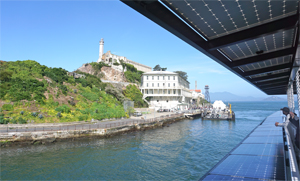Alcatraz Flyer was about to get underway from San Francisco’s Pier 33 when a passenger approached the wheelhouse. The young man, speaking with an Eastern European accent, wondered if anyone could swim from Alcatraz to shore.
He was particularly curious if such a feat were possible given the “dangerous sharks” lurking below the surface. Brian Dobruck, the vessel’s first officer, offered an answer both reassuring and perhaps a tad disappointing.
“People swim it. There is something swimming there right now,” Dobruck said. “There are no dangerous sharks. That is just something the guards would tell the inmates.”
Such is the mystique surrounding the former Alcatraz Federal Penitentiary that even its myths are known around the world. The former island fortress turned federal prison became a tourist attraction in 1972 operated by the National Park Service. Nearly 1.7 million people visited last year, and every one arrived via Alcatraz Cruises.
Capt. Ryan Palmer joined the company, owned by Hornblower, more than three years ago after working for a Los Angeles tour boat operator. He was drawn in part by the island’s history and the allure it has for so many visitors.
“Not a lot of people can say they have such a cool place to work,” Palmer said after docking at Alcatraz Island on a sunny, warm May morning. “You look over at the passengers along the side of the boat and they are in awe.”
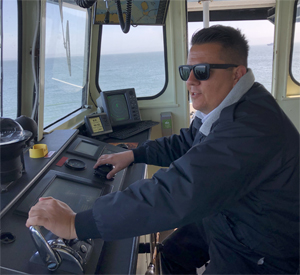 |
|
Capt. Ryan Palmer joined Alcatraz Cruises as a port captain more than three years ago. “Not a lot of people can say they have such a cool place to work,” he says. |
The 1.25-mile voyage from the mainland began just 15 minutes earlier. Positioned at the starboard wing station, Palmer backed the 128-foot diesel-electric hybrid off the pier. He spun the stern 90 degrees, then pointed the bow north.
Palmer steered the ship from the center wheelhouse while Dobruck kept lookout alongside. Although the crossing itself is short, every trip is different. Tidal currents move as fast as 4 knots in the main channel and up to 6 knots around the island. Winds from the west are a near constant in San Francisco Bay, and commercial and recreational vessels are always coming and going. Fog is another challenge.
The 22-acre Alcatraz Island, with its historic lighthouse and white prison buildings, came into focus as the ship sped along at 8 knots. Alcatraz Flyer normally docks starboard side to the landing, requiring captains to sail past it, then spin 180 degrees. Palmer steered from the starboard wing station, occasionally peering over the side to gauge distances from the dock.
Knowing the tides and their characteristics is an important part of each approach to Alcatraz. Flood tides tend to push on the stern during docking, while ebb tides often work against the bow. This isn’t always the case, however, and on this particular voyage the current pushed the ship away from the dock.
“If you’re not paying attention, you can get into trouble pretty fast,” Palmer said.
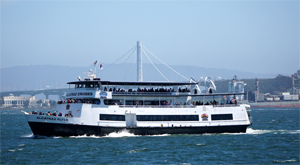 |
|
Alcatraz Flyer makes headway with the eastern span of the Bay Bridge in the background. Wind turbines installed aft can supply ship service power. |
“The toughest landings are the ones without a current,” Dobruck added, noting that captains often expect forces on the bow or stern and plan their approaches accordingly.
San Francisco Bay is home to some of the cleanest-running vessels in the country, with multiple Tier 4-rated tugboats, Baydelta’s new diesel-electric hybrid tug Delta Teresa, and Enhydra, Red and White Fleet’s battery-electric hybrid. The diesel-electric hybrid systems aboard Alcatraz Flyer and its sister ship, Alcatraz Clipper, predate all of these.
The hybrid systems on Flyer and Clipper consist of twin MTU Series 60 generators producing electric power for Baldor motors that turn the shafts. Roughly 150 batteries installed in void spaces provide backup power. Typically, captains run on a single genset to reduce fuel consumption and emissions.
Dozens of solar panels and two wind turbines installed aft of the upper deck generate energy for house power, reducing the load on the gensets. This system, effectively designed in-house, was installed on Alcatraz Flyer in 2013.
Palmer previously operated nearly identical ships in Southern California, albeit with conventional propulsion. Both versions, he said, handle well, particularly when “walking” to the dock. Extra weight from the battery banks and a momentary lag due to the power transfer from the gensets to the electric motors are about the only differences.
“(The hybrid) has the same characteristics, but it is just much heavier. It sits a little lower,” Palmer said. “You have to be 10 seconds ahead in your thought process as you make maneuvers and adjust accordingly.”
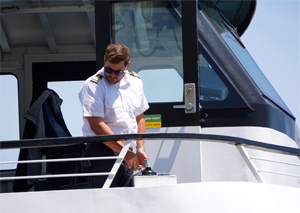 |
|
Capt. Chase Borchers checks the distance from the dock as the diesel-powered Islander arrives at Alcatraz Island. |
After docking, Dobruck and deck hands Stephen Chapman, Taylor Campbell and Jamie Bartlett worked together to usher the 281 passengers off the ship. Although Alcatraz Flyer can carry up to 700 people, it rarely exceeds 500 due to National Park Service limits. Those rules cap the number of people on the island at any time. The park service also sets admission prices, which include the round-trip boat ride.
The return voyage took a slightly different route, bringing the ship farther west than the inbound run. This is done in part to ensure sufficient spacing between other company vessels sailing to the island. Along the way, passengers flocked to the upper deck to snap pictures of Alcatraz and the San Francisco skyline. The approach into Pier 33 allows captains to dock bow-first.
Palmer’s second round trip of the morning commenced about 15 minutes later at 1130. The upper deck was packed with excited children visiting the island on a school outing.
“The kids are very excited to be here,” Dobruck observed.
“It’s Alcatraz, baby,” Palmer quipped.
The second voyage of the morning proceeded just as the first. Deck hands positioned forward and aft called out “all clear” as the vessel backed away from the dock. The course and heading were nearly identical, but winds were now gusting 25 mph from the west, raising an occasional whitecap on the bay.
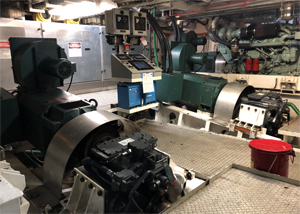 |
|
Alcatraz Flyer can deliver 1,400 horsepower from twin MTU Series 60 generators linked to Baldor electric motors. Roughly 150 batteries are available for backup power. |
Vessel traffic had picked up considerably. White sails dotted the horizon, and fast ferries zigged and zagged in every direction. Palmer maintained course as U.S. and Chinese teams sailed F50 catamarans toward the Golden Gate Bridge ahead of a weekend competition. The high-end sailboats, capable of reaching nearly 50 knots, slowed down considerably to let the larger vessel through.
“They are professionals. They know what they are doing,” Dobruck said of the racing crews.
Just a few minutes later, Red and White Fleet’s tour boat, Royal Prince, rounded Alcatraz’s north side as Palmer approached from the south. Royal Prince crept along to give its guests plenty of time to see the prison buildings, and its captain stayed a couple of hundred yards from the island.
“Royal Prince, looks like you’re taking it wide, so let’s do starboard to starboard,” Palmer called to his counterpart over radio, noting the vessel’s wide berth from the island’s dock.
“Roger,” the Red and White captain confirmed, “starboard to starboard.”
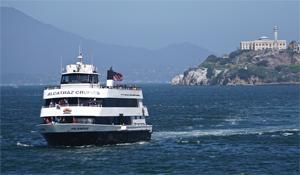 |
|
Islander heads back across the bay to take on another group of tourists. |
“Everyone knows what everyone else is doing,” Palmer said, referring to other tour and ferry operators. “So it all works out.”
As he did before, Palmer passed the Alcatraz dock and then spun around toward the landing. The current more or less cooperated this time as he guided the vessel against the dock. The island’s high bluff offered some protection from the westerly winds, and the 2-knot facing current made for a smooth docking maneuver.
Some mariners would have a hard time doing the same thing, multiple times a day, five days a week, month after month. Others, like Palmer, appreciate it.
“There is consistency to it,” he said. “We also get to meet all kinds of people from all over the world. They are super happy to be here, and seeing the expressions on their faces is pretty great.”
Behind Palmer on the upper deck, passengers lined the starboard side of the boat, aiming smartphones and digital cameras toward the island. The prison’s infamous cell house, once home to gangsters Whitey Bulger, Al Capone, “Machine Gun” Kelly and hundreds of lesser-known convicts, loomed on the bluff.
Without missing a beat, Palmer walked to the microphone. “Here we are, folks,” he said. “Welcome to ‘The Rock.’”

